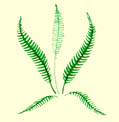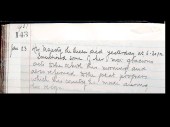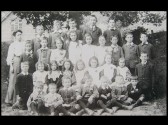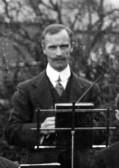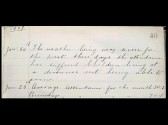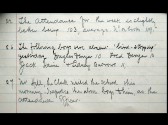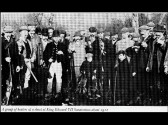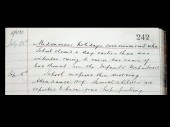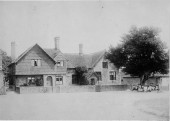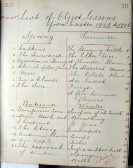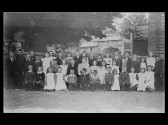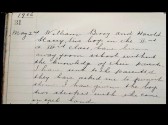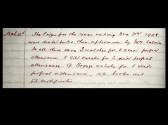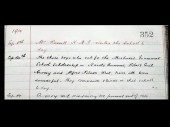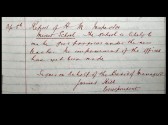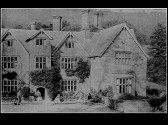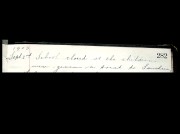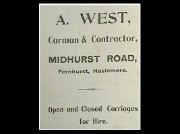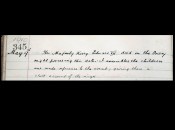The Fernhurst Society
A Glimpse of Edwardian Fernhurst: school days
by Brenda Newman, 2004.
Click on any image to see a larger version (note: the larger images may take a minute to download over slow internet connections).
As this is a glimpse of Edwardian Fernhurst schooling, let’s start with 23 January 1901, when Mr Herbert Watts, the Headmaster, records in the school log book “Her Majesty the Queen died yesterday (22 January) at 6 30 pm. I mentioned some of her most gracious acts to the school this morning and also referred to the great progress which this country has made during her reign”. The children, later, were given an essay to write on “The Queen” and a prize was promised for the best one.
The beginning of 1901 brought snowstorms, which affected school attendance, and unfortunately for Mr Watts two of his teaching staff were to resign, one teacher resigning after only two months at the school, complaining that she was unable successfully to teach two standards, viz I and II, and another leaving for a more lucrative post than that at Fernhurst. He wrote in his monthly report to the School Board that “the constant changes occurring in the staff seriously interferes with the work of the school”.
However, Mr Watts would be leaving in the Spring of 1903, after nine years as Headmaster. He was well thought of and was overwhelmed when a gift was presented to him on his last day, of a barometer with a clock and heat register, mounted in carved oak with an inscription. He also received a purse of gold and two presentations from past and present pupils. A gift of a barometer seems highly suitable, as he and his predecessors and successors were avid recorders of weather conditions in the school log books.
Mr Arthur A Burrows, aged 32, was the next Headmaster but he resigned the post after only a year, to be appointed to the staff of the West Sussex Education Committee. His first entry in the log book records “the children are unpunctual, very lax in obedience to orders and unmannerly”. However, the children’s manners seem to have improved two months later. The drains were a significant problem during his time. In particular, the “noisome stench” coming from the girls’ lobby, and which spread, made Mr Burrows record one morning “it was so bad that one could hardly face it”.
During his short time, he took the 1st form boys to Verdley Place to have a practical lesson on “Storage of Electricity” and the “Dynamo”. Violin class and French class after school were also taken, but there is no record of these continuing after Mr Burrows left. He complained many times of shortages of supplies and the lack of teachers. His last log book entry was on 23 February 1904: “No fires to-day, coal exhausted”. He left the School three days later!
I’ll only mention, now, three of the longer serving teaching staff: Miss F E Symes who was Mistress of the Infants Department from 9 February 1903 until leaving in 1914; Mr Harry Andrews, aged 30, who joined as Headmaster of the Upper School on 29 February 1904; and Miss Mary Lindsay, aged 23, who joined as Assistant Mistress on 11 March 1901. Both Mr Andrews and Miss Lindsay remained at the school until they both left on the same day on 31 August 1936, and here she is in the photo, on the left.
The teaching staff involved themselves in other village activities. They all taught Sunday school, which the Reverend Douglas Barton acknowledged would have collapsed without their assistance. Sunday school was held at the Fernhurst School, it being the only facility to hold a large number of people until the Village Hall was built in 1909. The School was also used for other village events such as evening concerts and parties, and also used for Parish, County and Parliamentary elections (of which there were three), when the School would be closed for a holiday.
Mr Andrews would become involved in, among other things, as Superintendent of the Sunday School, the Choirmaster, String Band, the Football Club and Recreation Committee.
Let’s take a look at some of the things Mr Andrews and Miss Symes had to record in their log books.
One can sense Miss Symes’ frustration when she records some children starting the Infant School over age and not knowing their letters and being very backward. In April 1909 she records: “Admitted seven new children. They are all over five years of age. William Morley is eight years of age in July next. His mother states that he has not attended school regularly owing to ill health. He has been in hospital some time”. In September Miss Symes removed his name from the books, as he was suffering from tumour on the brain and would probably not be able to attend school again; he had always been of weak intellect. There were also instances of children kept at home until a younger sibling was of age to go.
Weather played a large part in school attendance, the log books recording all kinds of rough, cold and wet weather, snowstorms and frosts. For those children living on the outskirts of the Parish, it meant a long walk in all weathers along bad roads. It does seem that winters then had more snow and were colder and wetter than to-day.
This log book entry of 24 Jan 1907 reads: "The weather being very severe for the past three days, the attendance has suffered. Children living at a distance not being able to come".
It was a regular occurrence for boys to be illegally employed as “bird stoppers” on the local estates during the winter months, despite the Headmaster of the time complaining to the landowners’ agents. One shilling was the going rate for each boy in 1900. Bilberry picking in the summer and especially hop picking in September, when whole families would all go off, also contributed to children missing school.
This log book entry of 26 Nov 1901 reads: "The following boys were absent 'bird-stopping' yesterday: Douglas Denyer 10, Fred Denyer 12, Jack Haine & Sydney Burrows 11."
And these four young boys were still working with the beaters in 1912.
Not only bad weather affected attendance but also illnesses and epidemics, which were commonplace then, such as measles, mumps, whooping cough, chicken pox, scarlet fever, diphtheria, German measles. An outbreak of measles occurring in 1903 caused the school to be closed on the orders of Dr Duke. It re-opened four weeks later. Again, in 1907, the school was closed for seven whole weeks on account of measles, only to be followed immediately by whooping cough.
This log book entry of 28 July 1904 reports: "Midsummer holidays commenced - 5 weeks. School closed a day earlier than was intended owing to one or two cases of bad throat in the Infants' Department."
Schooldays were not without hazards.
On 10 May 1901 the whole village was shocked by a fatal accident at the school. During playtime that morning, while several children were swinging round the giant stride, the pole broke off suddenly and fell upon one of the children, Ada Rozier (13 years of age) and killed her. One other child, Bessie Ralph, had her arm broken. School was promptly closed for the afternoon, and three days later school was closed during the afternoon so that the children might attend the funeral.
The log books record that in July 1905 the end of a child’s finger was crushed when one of the desk tops fell over, this was after Mr Andrews had repeatedly reported to the School Managers the unsafe condition of several desks.
In February 1909 a large piece of plaster fell from the ceiling in the main room of the school. One child was slightly cut and several bruised slightly.
Sadly, on 6 September 1910, Charles Berry (11½ years of age) of Chapel Street, a pupil of the school, was helping in the harvest field when the horse he was riding shied and he was fatally injured. The Parish Magazine records he was buried four days later.
Lessons taught were not so very different from our school days. In the earlier years slates were used but paper, pen and ink were now being used.
Observation lessons and nature walks were often taken for the last half hour of the afternoon.
Exercise was a form of drill with dumb-bells in the school yard, which if the weather was wet made the yard in an unfit condition, and then singing, recitation or reading took its place. In extreme hot weather a “gentle march” through Millhangar would be taken, in place of drill.
The 23 March 1905 log book entry includes a syllabus or list of observation lessons.
At the end of 1907 the School Managers decided to introduce gardening for the older boys. At the beginning of 1908 simple cookery classes for older girls commenced under the instruction of Miss Lindsay.
The Parish Magazine wrote at the time: “That the cooking taught shall be such as to enable every girl, when she leaves the school, to cook a working man’s dinner, and to cook it well. It is something to know what food is most nourishing and how it can be prepared most economically, and to encourage a distrust in tinned salmon and such labour-saving atrocities. If English housewives could learn to cook such a common article of food as a potato, it would work quite a revolution in the land. Nothing can be better than well-cooked vegetables, nothing nastier when badly cooked. It is generally agreed that this question has a direct bearing upon the drinking habit, the greatest curse of our country. A wholesome well-prepared meal will do wonders in destroying the craving for drink.”
I think I hear Jamie Oliver crying “Hear, Hear!”
Punishment was the cane, mostly for boys but a few girls also received cuts on the hand. Being disobedient and insolent to the teacher warranted four on the hand and four on the seat.
The log book entry of 2nd May 1906 notes: "William Berry and Harold Stacey, two boys in the 2nd and 3rd class, have been away from school without the knowledge of their parents. I have said to the parents, & they asked me to punish them. I have given the boys two strokes with the cane on each hand."
To encourage attendance at school, prizes such as a silver watch for five years’ perfect attendance and a gilt watch for three years’ were highly prized.
The 12 March 1909 log book entry reads: "The prizes for the year ending Dec 31st 1908 were distributed this afternoon by Mrs Salvin. In all there were 3 watches for 5 years' perfect attendance, 3 Gilt medals for 3 year's perfect attendance, 9 Bronze medals for 1 year's perfect attendance, 44 books and 52 certificates."
In 1910 three Fernhurst lads (Alfred Nelson West of Midhurst Road, Robert Cecil Hersey of Upper Cross, and Harrold Burrows of Ashurst) gained Scholarships to attend the Midhurst Grammar School. They received congratulations from the Village. No buses were available then, so there was the great problem of transport. Nelson West, apparently, went by pony for a period and finally stayed in Midhurst during the week. The other two boys either walked or were given lifts on horses and farm carts. A year later Arthur Edward Boaz of Jackets also gained a Scholarship to Midhurst Grammar School.
Regular visitors to the school were the School Managers and Mr James Hill, who was the clerk or correspondent to the School Board and attendance officer. They examined the registers and usually pronounced them correct and in order. The more formal HM Inspector of Schools would visit to inspect the school and the teaching methods and recommend improvements.
For the 5th September 1910, the log book records the following: "Report of HM Inspector. Mixed School. The school is likely to make good progress under the new teacher. No improvements of the offices has yet been made."
After school activities for children were the Children’s Guild for the over sevens and the Girls and Young Women’s Club for the over fourteens. Scouts were formed in 1909, the first patrol of 12 lads under Captain Lambert of Lower Lodge.
Dr Duke’s first aid lectures for men and boys were well attended. He also gave instruction in first aid to the Scouts, and home nursing for women under the rules of the St John’s Ambulance Association. Miss Symes and Miss Lindsay were among the women and older girls who attended.
And of course, a good many children attended the Fernhurst or Henley Sunday schools and some were in the choir.
Treats and holidays were looked forward to.
An invitation to Blackdown House was a regular summer highlight for the children. In July 1906 Mr and Mrs Philipson-Stow invited 350 Fernhurst and Camelsdale children and 30 teachers and friends to a fun-filled afternoon with tea, which was described as “They never had one single moment to think of what was coming next. Every moment was occupied”.
The Parish Magazine records one school treat of September 1907 when 350 Fernhurst and Camelsdale children met in Mr Voller’s Glebe field (off Hoggs Hill) for races and games, and followed by tea and an entertainer in the Vicarage garden. In a rash moment the Reverend Douglas Barton hinted that a boy who climbed the monkey puzzle tree might qualify for a prize, never dreaming that one would. However, one Fernhurst boy couldn’t resist and climbed the tree to the top!
I wonder who that boy was?
If subscriptions had been raised and funds permitted, then a school treat to the seaside was arranged.
Here is a write up in the Parish Magazine of the outing to Southsea on Wednesday, 2 September 1903: -
“At 6 30 am four large wagons were rapidly filled with children and their parents, and a few minutes later other smaller carts and carriages were joining the long procession up Friday’s Hill.
“The first stage was the station. All were comfortably in time, and a party had collected at 8 am, numbering well over 200. From there an easy journey was made in our special carriages to Fratton, at which point all got out and made their way, some on foot, or by tram, and others by the tiny motor train to East Southsea and the sea. Thanks to the early start, the children and their guardians were on the beach before 10 am, and then began the long happy day. There was paddling, boating, bands and peep-shows, and all kinds of curious photographers, fruit-sellers and sweet-sellers, besides whole armies of other children such as never find their way into our green lanes of Fernhurst. Those who cared for none of these things watched the ships and steamers or went off on excursions to the Island and back, while some made a pleasant little trip round the harbour, visiting Nelson’s old ship, the Victory, and getting a good close look at a few of England’s sea going giants.
“At half past three there was a general rallying of the party, and a long straggling line of rather tired holiday makers wound across the Common to have tea at Smith and Vospers.
“A little after 7 pm the Portsmouth division got into their special carriages again, to be joined by the main body at Fratton, and then there arose an impromptu concert which those who heard it, and those who helped in it, declared to be very fine indeed.
“At half past eight Haslemere was reached, and a tired happy crowd began climbing into their wagons and carriages to make the last stage of the journey home. At this point a little rain fell, but the day was done.
“So ended our summer outing. It was a great success, a day to be remembered and I trust repeated. The only misfortune was that two boys missed their guardian and their train home, but the railway authorities most kindly stopped the express for them at Haslemere. Their absence naturally caused their parents great anxiety, and in one case their mother and sister a sleepless night in the station waiting room. But all’s well that ends well. The feature of the day was the early time of starting and the number of the wagons lent.
“All were deeply grateful to Lord Davey, Mr Bridger of Lower Lodge, and Mr Alf West for sending their wagons on both journeys, and to Mr West of the Mill for sending his wagon in the morning. The loan of them at harvest time was especially kind.”
I am closing now with Mr Andrews’ school log book record of 9 May 1910, where he wrote that His Majesty King Edward VII died on Friday night, 6 May. Mr Andrews assembled the children and made reference to the event, giving them a short account of the reign.
The Edwardian era had ended.
Sources: The Fernhurst Archive; Fernhurst Parish Magazines; Fernhurst School Log Books - 1884-1904 and 1904-1911 (Infants), 1895-1921 (Upper School); Brian Silver Book “Fernhurst including Kingsley Green and Henley, Pictures and People”
The Fernhurst Archives
Fernhurst History
